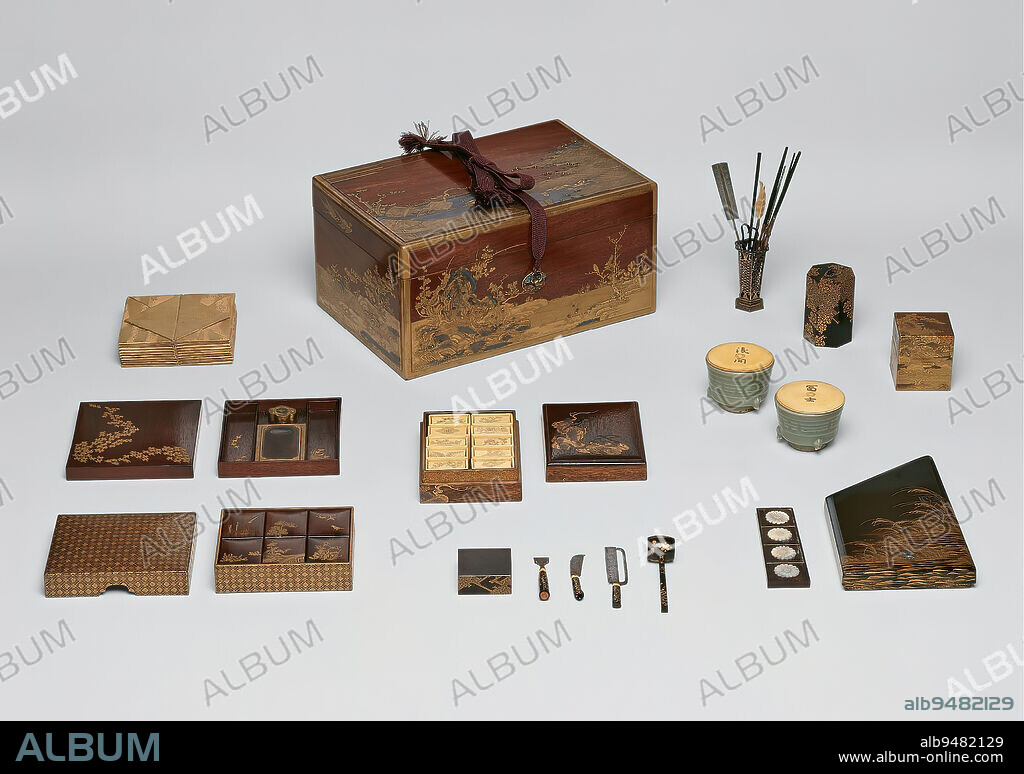alb9482129
Box and assorted implements for the incense game, 17th-18th century, Unknown Japanese, 6 × 11 7/8 × 8 in. (15.24 × 30.16 × 20.32 cm), Wood, lacquer, gold; metal utensils, Japan, 17th-18th century, Incense played a prominent role in aristocratic culture of ancient Japan. Aristocrats were expected to know how to mix aromatic imported woods with other plant products and compound them into burnable, fragrant incense. Popular ingredients included aloe, sandalwood, frankincense, pine, lily, cinnamon, and patchouli, among others. In the 1400s, this artful appreciation of incense developed further into the so-called Way of Fragrance, or kd, along with the Way of Tea (sad or chad) and the Way of Flowers (kad, better known in the West as ikebana). In incense-based games, played with the set displayed here, participants take turns smelling, appreciating, and guessing the ingredients of a certain type of incense. In one variation of the game called 'Genji Incense' or Genjik, types of incense or combinations thereof hint at chapters of The Tale of Genji.

|
Add to another lightbox |
|
Add to another lightbox |



Buy this image.
Select the use:

Caption:
Box and assorted implements for the incense game, 17th-18th century, Unknown Japanese, 6 × 11 7/8 × 8 in. (15.24 × 30.16 × 20.32 cm), Wood, lacquer, gold; metal utensils, Japan, 17th-18th century, Incense played a prominent role in aristocratic culture of ancient Japan. Aristocrats were expected to know how to mix aromatic imported woods with other plant products and compound them into burnable, fragrant incense. Popular ingredients included aloe, sandalwood, frankincense, pine, lily, cinnamon, and patchouli, among others. In the 1400s, this artful appreciation of incense developed further into the so-called Way of Fragrance, or kd, along with the Way of Tea (sad or chad) and the Way of Flowers (kad, better known in the West as ikebana). In incense-based games, played with the set displayed here, participants take turns smelling, appreciating, and guessing the ingredients of a certain type of incense. In one variation of the game called 'Genji Incense' or Genjik, types of incense or combinations thereof hint at chapters of The Tale of Genji.
Personalities:
Credit:
Album / quintlox
Releases:
Model: No - Property: No
Rights questions?
Rights questions?
Image size:
3240 x 2280 px | 21.1 MB
Print size:
27.4 x 19.3 cm | 10.8 x 7.6 in (300 dpi)
Keywords:
1400S • 17TH-18TH CENTURY • ANCIENT JAPAN • APPRECIATING • ARISTOCRACY • ARISTOCRAT • ARISTOCRATIC CULTURE • ARISTOCRATS • ARTFUL APPRECIATION • ASSORTED IMPLEMENTS • BETTER • BLOOM • BLOSSOM • BOX • BOXES • BURNABLE • CENSER • CERTAIN TYPE • CHAD • CHAPTERS • CHEST • CINNAMON • COFFER • COMBINATIONS THEREOF HINT • COMPOUND • EXPECTED • FAIRY TALES • FLEUR • FLOWER • FLOWERS • FRAGRANCE • FRAGRANT INCENSE • FRANKINCENSE • GAME • GENJI INCENSE • GENJI • GENJIK • GOLD • GOLD, ALL • GOLDEN • GOLDSMITH • GUESSING • IKEBANA • INCENSE DEVELOPED FURTHER • INCENSE GAME • INCENSE PLAYED • INCENSE • INCENSE-BASED GAMES • INFUSION • INGREDIENTS • JAPAN • JAPAN. • JAPANESE • KAD • KD • KNOW • LACQUER • LILY • METAL UTENSILS • MIX AROMATIC IMPORTED WOODS • NOBILITY • NOBLE • NOBLEMAN • NOBLESSE • PARTICIPANTS TAKE TURNS SMELLING • PATCHOULI • PINE • PLANT PRODUCTS • PLAYED • POPULAR INGREDIENTS INCLUDED ALOE • PROMINENT ROLE • SAD • SANDALWOOD • SET DISPLAYED • TALE • TALES • TEA • TYPES • UMBRELLA PINE • UNKNOWN JAPANESE • VARIATION • WAY • WEST • WOOD
 Pinterest
Pinterest Twitter
Twitter Facebook
Facebook Copy link
Copy link Email
Email
